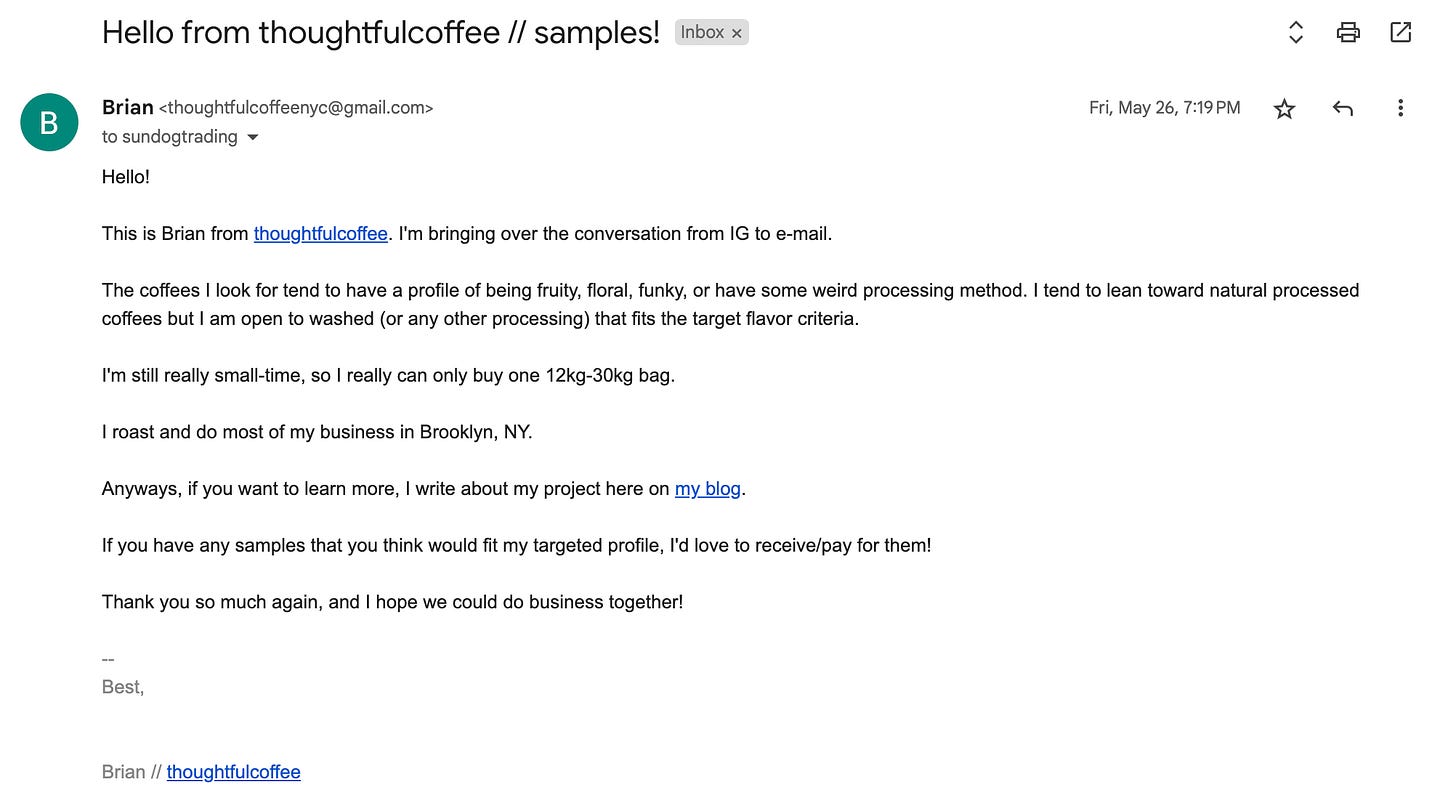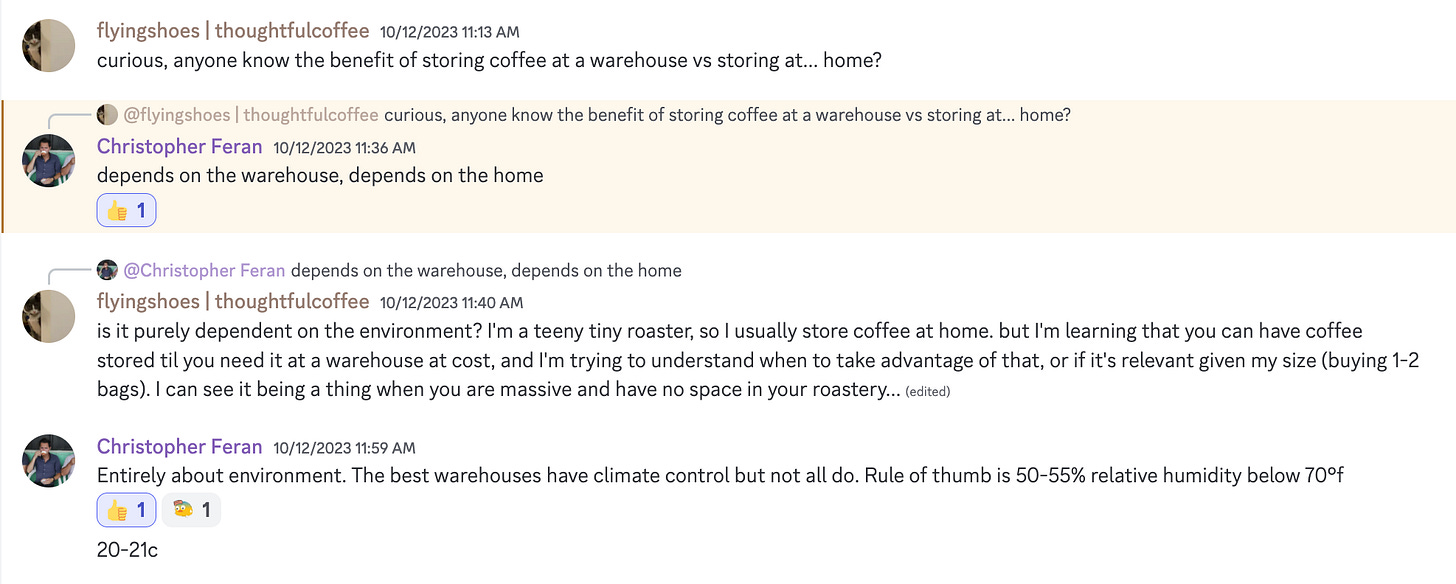“It would be really cool if you did a video talking about how you chose the coffees…”
“Also maybe some more insight into the green coffee selection process.”
Many of you have asked about my process of sourcing greens and dialing in my roasts. In this post, I share my methods.
What I've put together below is mainly from trial and error. So please take whatever I'm saying with a grain of salt. Some of it might seem backward regarding foundational coffee roasting practices, but they work for me and my small-time operation.
All opinions and spicy takes are my own.
Some basic definitions:
Coffee samples: This is a small increment (100-200g) of green beans sent to a roaster so they can roast and assess the greens to determine whether they want to commit to a larger purchase (24kg+).
Sample roasting: Roasting to assess whether the beans fit your buying profile. The intent is different from "production roasting, " which is to dial in the beans.
Green sourcing:
For sourcing, I'm usually working at a layer above the farmers — the middle-man exporters. I remember reading that farmers usually don’t do direct since it’d require them to handle the complex shipping logistics, to find a market for themselves, etc…
The farmers I have directly worked with (Benitez + Bermudez) had separate staff members managing their shipping logistics. I'd speak with the farmers about the details of their coffee. When I was ready to commit to purchasing, the farmers would redirect me to someone else who would handle information collection/payment/shipping.
With exporters, the conversation starts with me sending an intro email explaining my project, how large my operation is, and what sort of coffee I'm looking for. From there, they'll send over a listing of their coffees, and I'll choose which coffees I'd like to sample. Sometimes, the exporters will suggest what greens might best fit my profile; other times, I will solely pick which coffees I want to sample.
How I pick the coffees I want to sample are mainly off of varietal, processing, price, and farm/farmer.
Varietal:
If an exporter offers a gesha, bourbon, or a caturra that is within my price range, then I'll usually include that bean in my list to sample. I've found that I've had a lot of luck with sampling those varietals, so I somewhat skew to them nowadays too.
Processing:
I view processing as a way to help expand my (and yours if I commit) perspective on how coffee can taste. If coffee has an interesting processing method (ie, co-ferment, yeast inoculation, etc.), I'll give it a chance.
Price:
The price range I'm comfortable buying at is anything below $18 per lb (including shipping).
Farm/Farmer:
If there's a farmer I've bought coffee greens from before and enjoyed, I'm likely to buy from them again. An example of this is Wilton Benitez. I purchased his Koji Caturra for V3; many people enjoyed that coffee. For V5, I reached out to see what other coffees he was selling, and I ended up purchasing lots to use for both V5 and V6.
INCOMING HOT TAKES 🌶️:

I don't make any purchases without sampling the coffee first. I've been burned by this before, I bought a coffee without sampling from an exporter because I enjoyed something they produced prior. I then spent months trying to dial it in, and could not come up with anything I liked. So now, I make sure to always sample first before buying. The downside of this is that I rarely can participate in coffee green sales since exporters usually don't send samples out for discounted beans, or I can’t finish my sampling process before the sale ends.
I don’t put much weight on coffee scores/awards. Taste is subjective, and what someone likes might not be something I like, so I try not to put too much weight on how others judge a coffee. It’s just easier to treat each coffee as is.
I ignore the coffee notes that are suggested for the coffee. I've found it rare to taste 75% of what's usually listed. I feel listing tasting notes is a race of who can come up with the most elaborate notes. This is why my tasting notes are really high-level (fruity, floral, etc.). Or maybe my palette sucks ass (lol. Either way, if I can't specifically taste that note, I won't list it.
Sample roasting:
After receiving the green beans, the next step is to sample roast the greens.
The goal of sample roasting is to roast the greens for evaluation on whether you want to ultimately make a larger purchase (25kg+) of the greens or not. I go about sample roasting by starting with a base profile and then tweaking it as I see fit.
I think the usual approach here is to apply a single roast profile across all your samples to get a consistent baseline for evaluation. The issue is this biases your results to whatever beans best fit your base roast profile. I tried following this, as it makes a lot of sense. Then for one batch, some of the beans were softer (lower density) than usual and took on the heat a lot more eagerly than I was used to, resulting in me ruining all the softer samples.
So now, I start each sample roast with a base profile but adjust settings relative to how that bean/roast progresses. This adds a lot more cognitive overhead as I have to pay attention to each roast instead of taking a "set it and forget it" approach, but I feel this sets me up for a more accurate evaluation for each bean.
Once I reach the point where I have 100+ greens to sample, I'll likely revert to just having one baseline profile, as then, I can see efficiency being more of a priority. But I'll continue with my current approach since I'm still small and can afford the additional attention since I only have ~ ten greens to sample per batch.
Sample cupping:
As I'm progressing through these sections... I'm realizing my procedures differ from most online roasting advice because they are likely based on medium to large roasting operations…
After roasting the samples, I need to taste and cup the beans. I evaluate the beans by running them through a series of brew tests.
1. Sample roast the coffee
2. The next day, cup the coffee
3. Wait a week, and then re-cup the coffees (to account for rest)
4. Cut out any coffees that don't fit our target profile
5. Brew the remaining coffees over a simple V60 recipe
6. Assess and make decisions
When coming up with this process, I wanted to ensure that I would be able to incorporate steps that would allow me to taste how the coffee might brew in a household environment — where it’s brewed with a brewer (ie, V60, Hario Switch, etc.) and with consideration for rest.
HOT TAKE 🌶️:
Some things I do less are assessing for defects and consistency. Maybe it's because I haven't gotten burned yet for not checking for either, but if it tastes good, then I'm okay with any defects. Maybe I'm implicitly assessing for consistency as I'm brewing the beans multiple times, but I don't do the thing where you have 3 cups of the same bean, and you assess that all 3 cups taste the same.
As long as the coffee doesn’t seem like it’d be a health hazard (ie, if it isn’t radioactive blue or something — idk) to brew with, I’m going to prioritize for taste.
Coffee Purchasing:
Shipping gets better with scale. Shipping could affect pricing by pushing your base coffee green per pound costs up by $2 to $4. If you are wondering why my coffee bean prices are higher than the same coffee bean from a larger roaster like Sey Coffee or B&W, it's likely due to both shipping and other bulk discounts that they are eligible for.
One time, I was trying to ship two coffees, and the price to ship both in one trip vs shipping only one in one trip was the same. This forced me to buy all the coffees I wanted upfront rather than when I needed them, which isn't too bad, it just meant less flexibility on my side.
Production roasting:
After purchasing, the final step is production roasting the coffee. How I do this is I run the coffee through a few base profiles to get an idea of how the coffee will perform under different scenarios. How does it perform under hard heat application? How does it perform with extended development?
From there, usually, one or two profiles stand out, and I start iterating in that direction. I test by following a similar sample cupping approach. I continue iterating until I get a roast that I'm happy with.
The end criteria I aim for is something that's not roast-y and is expressive in its intended profile. I'm not aiming to develop the perfect profile, as that's a never-ending cycle. I'm aiming to roast something that tastes good enough for me.
Plus, I don't get to control the brewing, so many additional downstream factors could greatly influence how the end cup turns out.
This is why I try to write brewing guides for every bean I release. It’s a way for me to best help guide you (the buyer) to experience what I mean to share.
And that’s it! My perspectives, procedures, and opinions will change as I get deeper into coffee. There’s a lot left for me to learn and experience, and I’m excited to be further exposed to this domain.
Partners:
What I do cannot happen without the relationships I’ve made in the industry. From the green exporters I work with to operational partners to the cafes (hi villager) that support me, I’m beyond thankful for our relationship.
One thing that’s been touching for me is how humane people in coffee are. I’ve heard multiple times that people aren’t in this industry for the money, but instead, they are in it for the relationships, the community, and the drive behind sharing a good product.
From Frank over at Yellow Rooster Coffee in our email chain:
“Sure we would sell coffee to a roaster that wants minimal interaction because we know that money is still making an impact and we're rotating fresh coffee, but our objective is to be a humanity first company and form real, human connections.. both to share community and to make sure we're having the impact we intend to have.
It’s awesome that I get to work with businesses like Yellow Rooster Coffee.
Thank You’s:
Christopher Feran + S&W Roasting:
You've both answered so many of my dumb questions in EAF. From shipping logistics to green buying to general roasting tips, it's almost always one or both of you responding to my many questions. I owe you both a beer if I ever meet you in person.










